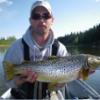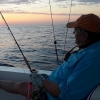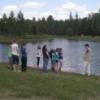Leaderboard
Popular Content
Showing content with the highest reputation on 10/02/2017 in all areas
-
While the ultimate onus is on the individual angler, it's in the best interest of everyone who benefits from the resource - anglers, guides, outfitters, fly shops, etc. - to convey the message to other anglers to clean their gear. Personally, I don't get a lot of people from out of town, out of province, or out of country calling me up for info when they come here. I'll bet fly shops, outfitters, and guides get those calls though. That's why a lot of the fly shops have signs up about cleaning your gear, reg changes, and emergency closures.4 points
-
3 points
-
I think there are likely many contributing factors and events such as the extended high flows of turbid water releasd in 2011 from a malfunction at one of the upstream power generators, which coated the stream bottom with fine clay from the high Alpine. These turbid flows which lasted through the summer into late autumn, reduced sunlight penetration down to the stream bed where aquatic vegetation and moss's grow. (The Sapro outbreak followed soon after). That year, I noticed a major reduction in many species of common Mayflies. The downward trend of aquatic invertebrates continues to this day, with many species of stoneflies, water boatman, back swimmers, fall caddis greatly reduced or virtually eliminated. Then came the flood of the century in 2013 which certainly had a huge impact on biomass loss and habitat. As for the water treatment upgrades, it has most likely had an impact on biomass reduction. The numbers of fish we now have is simply what the habitat can support. Rivers are living, dynamic systems that are constantly changing. The fish are healthy and not showing signs of major stress and disease, so maybe their numbers will rebound when conditions allow.2 points
-
Toolman: If there is a loss of habitat and food source due to whatever events have taken place, then as you say, the population of trout that the river can sustain has probably reached a low threshold. Hopefully that is not the case and we will see the current numbers of young trout survive, grow and reach the mature size that we have seen over the past 2 years.1 point
-
Yes, Education to all is so important, and is also up to us, retail and guides to openly talk about.1 point
-
Toolman has put his two bits in, which means the discussion, on the discussion forum, is now over. Refer to bow river population thread to continue discussion regarding the sky falling.1 point
-
I would agree that the compulsion for guides to be stewards of the resource is significant. They should be promoting adherence to the regs, invasive species risk reduction, and good fish handling techniques. Part of their role is not only education on how to get fish into the boat, but also educating their clients to do their part to ensure those fish are there the next year when that client (and others) returns.1 point
-
I have Hodgmans 3 in 1. Its warm and on the rainiest of steelheading days-weeks it has kept me warm and dry for 3 seasons now. There are also hand warmers in both the removable liner and the waterproof jacket.1 point
-
If the guide wants to protect the fisheries they use to make their living then it's their responsibility just like it's their responsibility to make sure the angler follows the regulations for each water body.1 point
-
http://www.patagonia.ca/product/mens-minimalist-wading-jacket/81831.html Patagonia warranty and quality at a good price. It's also light enough to pack down and carry easily. I roll mine up into the hood and carry it in the loops on my Vedavoo sling.1 point
-
Frogg Toggs? Their stuff seems priced well. I've only tried them on in store, but seem pretty well made. Haven't purchased one, so am limited on what I can give for testimonial.1 point
-
Are you committed to the pockets? If not, the outdoor research jackets are a great bang for the buck, and have a great gaurentee. I don’t think I’d buy a guide jacket again1 point
-
1 point
-
1 point
-
There is no doubt that Bow River trout populations are way down from what was seen in the '80 and '90 when there was a fraction of the anglers on the river as compared to what we see today. The habitat and food source has changed dramatically. To say that there is "a steady decline" is a conservative statement that researchers use in the absence of statistical data analysis! A few years back those with knowledge of the Bow suggested that there was "100 Years" of biomass in the river and that even with the clean up of Calgary's water treatment plants that trout would continue to prosper. Then came ther 2005 and 2013 floods that cleaned out large stretches of the river. Weed growth is minimal and aquatic species range has changed. There are encouraging signs that trout populations are on the rebound, especially the number of smaller fish on the lower stretch of the Bow between Mac and Legacy. What is needed now is to take pressure off the fishery with a better fish management model.1 point
-
My reply to question 16, when it asked for feedback: The AEP is trending in an extremely troubling direction. This department has been on the decline for a while, and this latest survey is exhibit A. (https://talkaep.alberta.ca/north-central-native-trout-recovery/survey_tools/north-central-native-trout-proposed-angling-closures) I have many objections: 1. I challenge the data and the methodology of determining the FSI's. 2. I demand public hearings and no more online surveys where biologists and department officials will actually ENGAGE with the angling public and listen to their concerns. Give us the numbers and provide evidentiary proof of diminishing populations, and then provide proof of correlation between angling pressure, the ineffectiveness of catch and release, and justify the closures on a cause and effect basis. 3. The AEP needs to be completely over-hauled in terms of its engagement policies with the angling public. They need to adopt a broad strategy of enlisting assistance from anglers while reminding themselves that they serve both the fish AND anglers’ needs. Currently, the Fisheries Round Tables, online surveys, etc., amount to nothing more than tokenism. 4. My strongest objection is the complete abdication of any sense of responsibility this department has in terms of serving what's best for fish. It is my belief that the biologists and officials have pre-determined outcomes and policies they are just going to implement without seriously looking at ALL the factors and variables that go into habitat degradation and diminishing fish populations. Why are anglers being punished for circumstances beyond their control? Why doesn’t the AEP issue directives, studies, policies, protocols, recommendations and reports detailing the incredible challenges facing all fish and fauna in the province with regards to industrial intrusion? Where is the AEP’s policy recommendations on aggressive logging practices, road densification, hanging culverts, improper allowances and setbacks, and habitat fragmentation? Is the AEP claiming that catch and release regulations are an ineffective management tool; and then using that as an excuse to close watersheds? Does the AEP anticipate fish population recovery will happen on the basis of removing anglers from the picture all while ignoring the aforementioned industrial impacts? Has the AEP anticipated the resulting increase in angling pressure during the next season, as more anglers are forced to fish fewer watersheds? My recommendations, instead of using (and the pretending to act upon this ludicrous survey) is to do the following: 1) Before changing any regulations – especially related to reducing angling opportunities and closing watersheds - how about dramatically increasing the enforcement, not only on recreational users, but industry too? Increased enforcement can be partially funded by the fines imposed. I see gross violations of industry frequently when I fish. 2) Identify the TRUE root causes of pressured or diminished fish populations, and then PRIOTIZE the needs to get them addressed. Most of the skepticism and outrage that I have heard from fellow anglers is that angling has been identified as a primary cause. I – and others – highly doubt this. I have fished many watersheds that have been catch and release since the last regulations were over-hauled, and the fishing has improved over the past 20 years. I’d venture to say based on my anecdotal observations that fishing is more impacted by industry, improper trail penetration, and erosion right now along watersheds that are already catch and release. 3) The AEP and other suitable government agencies should put pressure on industry groups to comply with policies outlined by the AB government as it currently reviews BOTH industrial and recreational usage along the Eastern Slopes. Issues related to fish populations recovery are far beyond the scope of just one single variable (angling pressure). 4) The Alberta Government overall should, plainly and simply, get their act together and develop an over-arching plan to ensure that riparian areas, fish and animal habitats, and water quality are going to be preserved for future generations. There is far too much fragmentation, segregations, and a stunning lack of coordination between various gov’t departments. Anglers have become the easy, knee jerk targets for the AEP to take the simplest way out in attempting to manage fish populations. It’s both bad science and bad policy. And the AEP needs a serious look in the mirror: something needs to happen to shake this department out of its bureaucratic entrenchment and self-internalized feedback loop. Otherwise, I fear all we are left with is nowhere left to fish, and no fish left. Please, I encourage you to speak up: John Tchir: John.Tchir@gov.ab.ca And, consider cc'ing the following people: Dave Park: dave.park@gov.ab.ca, Shannon Phliips: AEP.Minister@gov.ab.ca, Premier Notley: edmonton.strathcona@assembly.ab.ca , premier@gov.ab.ca,1 point
-
Closing those streams to angling without keeping the OHVs out or limiting logging in the headwaters isn't going to do a lot of good. It's really unfortunate that the OHV ban in the southern forestry area was lifted during bull trout spawning.1 point





